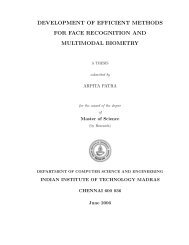The Enigma of Group Theory - Department of Computer Science ...
The Enigma of Group Theory - Department of Computer Science ...
The Enigma of Group Theory - Department of Computer Science ...
Create successful ePaper yourself
Turn your PDF publications into a flip-book with our unique Google optimized e-Paper software.
http://www.cs.bris.ac.uk University <strong>of</strong> Bristol, <strong>Department</strong> <strong>of</strong> <strong>Computer</strong> <strong>Science</strong><br />
2.2 Reflector<br />
<strong>The</strong>re were a number <strong>of</strong> reflectors used in actual <strong>Enigma</strong> machines. In our description we shall use the<br />
reflector given earlier, which is <strong>of</strong>ten referred to as “Reflector B”. This reflector has representation via<br />
disjoint cycles as<br />
ϱ = (AY)(BR)(CU)(DH)(EQ)(FS)(GL)(IP)(JX)(KN)(MO)(TZ)(VW).<br />
2.3 An <strong>Enigma</strong> key<br />
An <strong>Enigma</strong> key consists <strong>of</strong> the following information:<br />
• A choice <strong>of</strong> rotors ρ1, ρ2, ρ3 from the above choice <strong>of</strong> five possible rotors. Note, this choice <strong>of</strong> rotors<br />
affects the three notch positions, which we shall denote by n1, n2 and n3. Also, as noted above, the<br />
rotor ρ3 is placed in the left <strong>of</strong> the actual machine, whilst rotor ρ1 is placed on the right. Hence, if<br />
in a German code book it says use rotors<br />
I, II, III,<br />
this means in our notation that ρ1 is selected to be rotor III, that ρ2 is selected to be rotor II and ρ3<br />
is selected to be rotor I.<br />
• One must also select the ring positions, which we shall denote by r1, r2 and r3. In the actual<br />
machine these are letters, but we shall use our canonical numbering to represent these as integers<br />
in {0, 1, . . . , 25}.<br />
• <strong>The</strong> plugboard is simply a product <strong>of</strong> disjoint transpositions which we shall denote by the permutation<br />
τ. In what follows we shall denote a plug linking letter A with letter B by A ↔ B.<br />
• <strong>The</strong> starting rotor positions we shall denote by p1, p2 and p3. <strong>The</strong>se are the letters which can be<br />
seen through the windows on the top <strong>of</strong> the <strong>Enigma</strong> machine. Remember our numbering system<br />
is that the window on the left corresponds to p3 and that on the right corresponds to p1.<br />
2.4 <strong>The</strong> encryption operation<br />
We let σ denote the shift-up permutation given by<br />
σ = (ABCDEFGHIJKLMNOPQRSTUVWXYZ).<br />
<strong>The</strong> stepping <strong>of</strong> the second and third rotor is probably the hardest part to grasp when first looking at an<br />
<strong>Enigma</strong> machine, however this has a relatively simple description when one looks at it in a mathematical<br />
manner.<br />
Given the above description <strong>of</strong> the key we wish to deduce the permutation ɛj, which represents the<br />
encryption <strong>of</strong> the jth letter, for j = 0, 1, 2, . . . ,.<br />
We first set<br />
m1 = n1 − p1 − 1 (mod 26),<br />
m = n2 − p2 − 1 (mod 26),<br />
m2 = m1 + 1 + 26m.<br />
<strong>The</strong> values <strong>of</strong> m1 and m2 control the stepping <strong>of</strong> the second and the third rotors.<br />
We let ⌊x⌋ denote the round towards zero function, i.e. ⌊1.9⌋ = 1 and ⌊−1.9⌋ = −1. We now set, for<br />
encrypting letter j,<br />
k1 = ⌊(j − m1 + 26)/26⌋,<br />
k2 = ⌊(j − m2 + 650)/650⌋,<br />
i1 = p1 − r1 + 1,<br />
i2 = p2 − r2 + k1 + k2,<br />
i3 = p3 − r3 + k2.<br />
8










